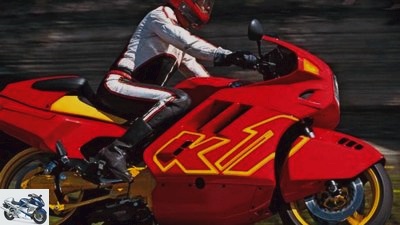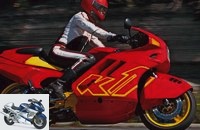Menus

Finale: the motorcycle of the future from BMW
Unforgettable: the BMW K 1
There was a time when BMW didn’t dare to build motorcycles with more than 100 hp. Instead, they tried to counter the competition with aerodynamics. The result was the K1.
What a shock: BMW hangs what is probably the largest fairing in the world on the K 100 RS and calls the whole thing K1. It should be a super athlete, which is why there shouldn’t be any suitcases, but instead a wedge-shaped front fender of unprecedented clunkiness. And then there is the almost vertical rectangular spotlight! What do Munich allow? Bottle too full?
None. It was sheer hardship. Psychological distress, because Munich was still a pioneer in terms of safety, environmental friendliness and social acceptance of motorcycling. And of course a more than 100 hp engine did not fit into the concept. For a long time, Munich stuck to the voluntary 100 hp limit, while the competition was already openly delivering well over 130 hp. In addition, there was physical hardship because at the end of the eighties there was no money to build a really new engine. And also none for an extra headlight. All of this is no longer an issue today, 20 years after K1. Today, with the S 1000 RR, the Munich-based company is sending a machine that is exactly twice as powerful into the race. A good 200 hp make this 1000 series the most powerful production motorcycle in the world. And it can even wear two different headlights.
Buy complete article

Finale: the motorcycle of the future from BMW
Unforgettable: the BMW K 1
K1 not. And the brick was well hidden behind the endlessly long panel. Nevertheless: The author was quite shocked when the first test drives with the Munich Wind Bride came up in 1989. Was that futuristic or just ugly? They chose futuristic. Always think positively. The most important thing: When starting off, first stow both shins in the side panels without accidents. And get out again at the traffic light. Many a K1 pilot fell like a sack on the intersection when his boots got caught in the fairing. Once on the move, the woman from Munich integrated you easily. The handlebars were pleasantly wide, the footrests not too high. One could bear that.
archive
The most famous pillion rider: Helmut Kohl on K1, Toni Mang as pilot, 100,000 cheering in Hockenheim.
The mighty cladding offered sensational weather protection. My K1 is my Castle, even heavy rain showers lost their horror. And in cool weather, the warm exhaust air from the engine delighted the driver’s knees and feet. From 30 degrees outside temperature, the soles of the shoes melted. There are even supposed to have been burns.
An extremely handy chassis geometry made the BMW curvy. And that despite a huge wheelbase of 1565 millimeters and a lush 264 kilograms. The narrow rear 18-inch device provided impressive neutrality. You could pretty much let it go. Many a Japanese four-cylinder pilot was amazed at the streamlined BMW sticking to the rear-view mirror. However, sporty contemporaries found the banking limit pretty quickly. Embarrassingly, on the K1, the fastening screws of the lower part of the fairing touched the asphalt first. They were ground flat and could hardly be opened.
So up on the highway. The K1 feels at home here like nowhere else. In the high-speed oases, which are not yet speed-limited, it slips through the wind like a rocket. The driver only had to duck a little to enjoy the full wind protection. You could do that for hours. From 200 km / h, it even increased again to run almost 240 things. That even made them quite stable and without any big antics. If it were translated a little longer, it could run even faster. The rev limiter put an end to the fast drift time and again. The builders did not allow their Brummer to exceed 9170 rpm. According to the MOTORRAD wind tunnel test, the K1 only needed 56 hp for 200 km / h and would reach a top speed of 242 km / h. Downhill with a tailwind, 250 items and more would have been possible. A sixth gear would have been needed for this. The K1 is probably the most streamlined motorcycle to date. No other machine can compete with the motorway qualities of the K1. However, that is no longer an issue.
archive
From the front you can see the bulky fender very nicely, futuristic, isn’t it?
The classic BMW driver was suspicious of the K1. No suitcases attached, but two small storage compartments in the rear, these also have fiddly locks. In addition, BMW demanded a whopping 20,200 marks for the racing car. This also slowed down the desire to buy. Production was stopped in 1993. After all, 6921 copies saw the light of day.
Anyone who owns one today can, in addition to the qualities described above, also enjoy good pillion suitability. Incidentally, the most famous partner was Helmut Kohl. Toni Mang drove the unit‘s chancellor around the track at the Hockenheim Grand Prix. MOTORRAD photographer Dave Schahl captured this unique scene on celluloid. Will Ms. Merkel take a seat in the back of the S 1000 at the Sachsenring this year? Or Guido? No!
Technical data of the BMW
archive
A clear view of the battery, ignition coils and the world.
Engine:
Four-cylinder in-line engine, water cooling, four valves per combustion chamber, two overhead camshafts, bucket tappets, bore x stroke 67 x 70 millimeters, 987 cm3, 74 kW (100 hp) at 8000 / min, 100 Nm at 6750 / min, injection, E- Starter, dry clutch, five-speed gearbox, cardan drive.
Landing gear:
Tubular steel frame, telescopic fork at the front, Paralever single-sided swing arm at the rear, mono suspension strut, double disk at the front, single disk at the rear, 305/285 mm, cast wheels, 120/70 VR 17 and 160/60 VR 18 tires.
Measurements and weight:
Wheelbase 1565 mm, caster 90 mm, seat height 780 mm, weight 264 kg, tank capacity 22 liters, top speed 236 km / h.
Price:
20200 Mark (1989)
Related articles
-
Hartmann 12 pictures archive 1/12 Narrow engine, tight fitting cladding, raised silencer – this is how the 916 enables inclines to beyond the …
-
Final: 25 years of the Kawasaki GPZ 900 R
Artist Final: 25 years of the Kawasaki GPZ 900 R Fire under the bum It opened a new era: strong, fast, stable. The GPZ 900 R, Kawasaki’s first ninja with…
-
Archive 10 images Archive 1/10 The choke in the disguise is spraying with Spartan charm. Archive 2/10 Gas factory: four Keihin equal pressure carburettors in …
-
Endurance test final balance: Aprilia NA 850 Mana
Archive endurance test final balance: Aprilia NA 850 Mana 50,000 kilometers with the automatic bike Mana mana, badibidibbi: Anyone who knows Sesame Street remembers …
-
Endurance test final balance: Suzuki Gladius
Archive long-term test final balance: Suzuki SFV 650 The 50000 kilometers of the Suzuki Gladius Very few found them beautiful, but with the faithful, Japanese …
-
Endurance test final balance of the Kawasaki Z 1000
Gargolov Endurance test final balance Kawasaki Z 1000 The naked bike after 50,000 km With the Kawasaki Z 1000, the 40-year tradition of the Z series …
-
Endurance test final balance of the Kawasaki ZX-10R
Bilski endurance test final balance sheet Kawasaki ZX-10R Too good to strip After 50,000 kilometers it is opened, looked inside and measured. So are the …
-
Endurance test final balance: BMW K 1300 GT
Bilski endurance test final balance: BMW K 1300 GT BMW’s travel steamer with problems in the engine room When it ran, the BMW K 1300 GT was a fantastic …
-
Honda Gold Wing GL 1800 endurance test final balance
Jacek Bilski 34 pictures ADAC 1/34 I’ve never taken apart an engine that looked so good, here everything looks more like 5,000 than 63,000 …
-
Endurance test final balance Triumph Sprint ST
Bilksi endurance test final balance Triumph Sprint ST Well done No doubt, the Triumph Sprint ST is one of the most dynamic and powerful …